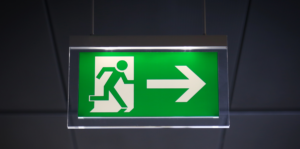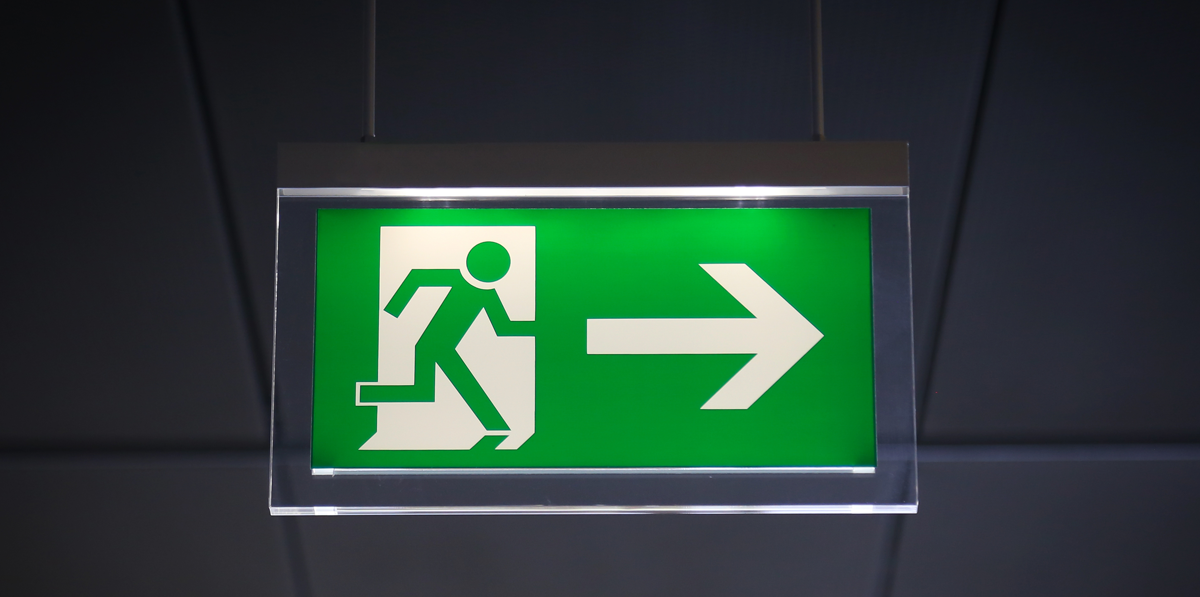As a retailer, you must have emergency lighting to make sure anyone can get out of your premises quickly and safely in the event of an emergency. But how can you make sure the lighting is working when you need it? Just as importantly, is it possible to have emergency lighting that is compliant without it being hugely expensive to maintain? We take a look at how you can have reliable, low carbon emergency lighting that is cost-effective to maintain.
Look around any retail space and you will notice they all have one thing in common: emergency lighting. As a retailer, it is a legal requirement to provide anyone inside a property guidance to help them escape in the event of an emergency. To do this, you will have emergency lighting located around in their premises. Of course, such lighting is only useful when working. So, any emergency lighting must be regularly tested, along with alarms and fire extinguishers.
In both cases, the test determines whether the lighting still operates when the mains power is cut. As emergency lighting must work even when there is no mains power, they will contain a battery backup. This is usually provided by nickel-cadmium and/or lead acid battery technology.
However, rather like a vehicle MoT, this doesn’t guarantee the lighting will remain fit for purpose for the next 12 months. Plus, the use of nickel-cadmium or lead/acid for battery backup has considerable environmental impact. So how can you have reliable, low-carbon emergency lighting that also reduces cost of ownership?
What is Emergency Lighting?
Any retail premises which have emergency exits that need illuminating must have emergency lighting. This is very different from other forms of the illumination of the property. When required, it must guide people to safety. A typical building will require emergency lighting in a number of areas, including:
- Exit doors
- Stairwells
- Corridors
- Escape signs
- Fire equipment
- Alarm Buttons
- Any changes in floor level
- Windowless rooms
- Toilets exceeding 8m2
- Outside each final exit
- Lifts
- Any internal area larger than 60m2
- Any equipment that must be shut down in the event of an emergency
For retailers will multiple locations, or for larger spaces such as department stores, malls, stadiums or large offices, the amount of emergency lighting required can be considerable.
Emergency Lighting And The Law
Any building which is accessed by the public, or where people are employed, must have emergency lighting. This is a legal requirement under The Regulatory Reform (Fire Safety) Order 2005.
Emergency lighting is subject to regular tests to ensure it is working correctly. This includes a monthly ‘flick test’ – where the power is briefly turned off – and an annual ‘full duration’ test, where the power is turned off for three hours. All tests and their results must be recorded. These testing frequencies are covered within BS5266 and BSEN50172.
The emergency lighting should also be included in the annual Fire Risk assessment. This is a detailed look at the premises and the ability to deal with the impact of a fire or emergency. If the retailer employs more than 5 people, this assessment must be written and stored.
Maintaining emergency lighting – along with other aspects of the fire safety hardware installed in the property, such as fire extinguishers and alarms – falls under whoever is the nominated Responsible Person.
To recap then, as a retailer you should ask yourself three questions around your emergency lighting:
- Do you have a nominated Responsible person.
- Is your Fire Risk Assessment reviewed and updated annually.
- Are your monthly, Flick Test, and annual 3-hour duration test records complete and recorded.
Failing to comply with the Order can result in unlimited fines and, potentially, a custodial sentence. So it is imperative that you must ensure you undertake your legal obligations in regards to emergency lighting and fire safety in general.
The Problem With Backup Power
As an emergency may include loss of power, emergency lighting must therefore operate separately from all other lighting in the property. It must also have a standby feature so that it can continue to work in the event of a power failure. As a result, emergency lighting commonly uses cadmium-nickel batteries to provide their energy. These have a considerable impact on the environment. Cadmium and nickel are known carcinogens, and such batteries contain other toxic materials such as lead, cobalt, and manganese. As their working life is low at 4 years, each location may need to stock new batteries and have a continual replacement strategy. Sadly, the vast majority are thrown away and not recycled. Although battery recycling rates are around 45%, this figure is skewed by the high level of recycling of lead-acid batteries, which make up nearly two-thirds of this figure despite only accounting for 4% of the total weight of batteries avoiding landfill.
A Test Is Not A Guarantee
As mentioned previously, the recommended testing regime is to have an annual duration test along with monthly ‘flick’ tests. For a duration test, the emergency lighting must operate for 3 hours. A monthly ‘flick test’ requires the power is briefly turned off to check the emergency lighting activates. In both cases, each light fitting must be visually inspected and the results recoded in the fire safety logbook.
Depending on the size of the property, these visual inspections could potentially be a very involving exercise covering countless dozens – or even hundreds – of fittings within the emergency lighting system. This presents a cost, both financial from paying a contractor to undertake the testing, and inconvenience to staff and customers alike. And ultimately, any test is only a snapshot. It is not a guarantee every single emergency light fitting will be working the next day.
A Reliable, Low-Carbon Alternative For Emergency Lighting
Faced with these issues – battery lifecycle, their environmental impact, and the issues surrounding testing and monitoring – the answer therefore lies in having an intelligent, environmentally friendly approach to how you power and monitor emergency lighting.
Store Maintenance has the perfect solution in the form of emergency lighting technology which will transform how you install and manage such systems in your locations.
Longer Lasting, Environmentally Friendly Energy
If we look at emergency power sources, the solution we install can use either Lithium Iron Phosphate or Lithium Iron Nanophosphate batteries. Both present a far lower impact to the environment as they contain no heavy metals and are free of carcinogens. Even better, they last far longer; in the case of Lithium Iron Nanophosphate, twelve years compared to Cadmium Nickel. So, they will require changing far less frequently. This results in the property sending less batteries to landfill and therefore reducing its impact on the environment.
Turning Your Emergency Lighting Into A Self-Managing Network
Alongside the extended life batteries, we also install a range of fittings which allow you to manage them intelligently. These are controlled by a central portal, with the fittings communicating with a Radio Frequency (RF) controller. This replaces data cabling and network hardware. When powered up, each fitting searches for, and connects to, the rest of the emergency lighting network. This in effect means your property has a dynamic, self-managing series of colonies of up to 1,000 emergency lighting fittings, which can be monitored from a single controller.
This ability of the fittings to self-discover and build their own network removes the need for additional cabling, making installation fast and easy to undertake. Simply fit and switch on – the fitting will then find others already installed. It also makes the network flexible; individual fittings can be relocated if required with the need for expensive, time-consuming additional hardware.
Once the fittings are live, access to them via their gateway gives a complete view of the network. For the property owner, the gateway console provides information on any fittings which are faulty, speeding up fault finding without resorting to testing the entire system. Another powerful reason for adopting this technology is its ability to hold maintenance and test records. This feature allows property owners to keep comprehensive histories of each fitting for each location, detailing every test and any repairs undertaken. Finally, the management portal can also integrate with Building Information Management (BIM) systems, helping to consolidate emergency lighting with facilities management to a single view across the estate.
“The Most Sustainable, Lowest Carbon Emergency Lighting Solution”
To provide compelling evidence of the advantages of this solution, the carbon impact of the management portal and light fittings powered by Lithium Nanophosphate batteries were analysed by infrastructure consulting firm AECOM.
Their investigation found that the solution presented a carbon saving up to 89% compared to other emergency lighting systems available, alongside a 50% reduction in energy consumption. They summed up the solution as “The most sustainable, lowest carbon emergency lighting solutions on the market”.
The Benefits Of Reliable, Low-Carbon Emergency Lighting
With Store Maintenance, you can the emergency lighting systems within your properties into line with ESG objectives. The long-lasting, environmentally friendly battery technology helps to reduce the amount of traditional toxic cadmium nickel products being sent to landfill. And the central management portal makes emergency lighting easier, and faster, to maintain. All from a system that is easy to install and doesn’t require extensive wiring or any third-party connectivity to operate.
If you are concerned with the expense and carbon footprint that emergency lighting presents to a commercial property, Store Maintenance provides a robust, scalable, and proven alternative which could bring major savings – and reduce your environmental impact. To improve the reliability, management and cost effectiveness of the emergency lighting in your locations.
Store Maintenance are specialists in the design, planning and installation of emergency lighting particularly Self-Test and Wireless systems. Our expertise can transform your emergency lighting into a reliable, low-carbon system which is cost-effective to maintain and simple to keep compliant. Contact us now to discover how you can reduce the cost and time to provide emergency lighting in your properties.









